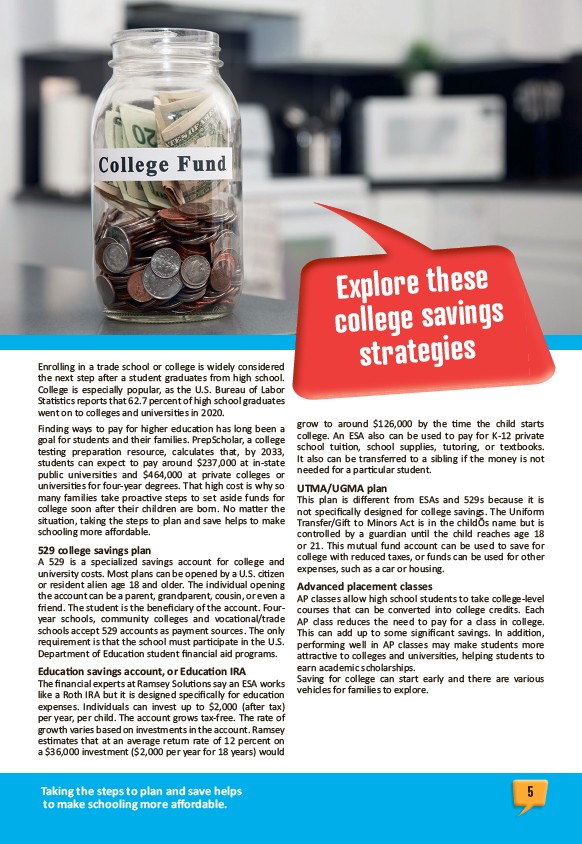
Taking the steps to plan and save helps
to make schooling more affordable.
5
Enrolling in a trade school or college is widely considered
the next step after a student graduates from high school.
College is especially popular, as the U.S. Bureau of Labor
Statistics reports that 62.7 percent of high school graduates
went on to colleges and universities in 2020.
Finding ways to pay for higher education has long been a
goal for students and their families. PrepScholar, a college
testing preparation resource, calculates that, by 2033,
students can expect to pay around $237,000 at in-state
public universities and $464,000 at private colleges or
universities for four-year degrees. That high cost is why so
many families take proactive steps to set aside funds for
college soon after their children are born. No matter the
situation, taking the steps to plan and save helps to make
schooling more affordable.
529 college savings plan
A 529 is a specialized savings account for college and
university costs. Most plans can be opened by a U.S. citizen
or resident alien age 18 and older. The individual opening
the account can be a parent, grandparent, cousin, or even a
friend. The student is the beneficiary of the account. Fouryear
schools, community colleges and vocational/trade
schools accept 529 accounts as payment sources. The only
requirement is that the school must participate in the U.S.
Department of Education student financial aid programs.
Education savings account, or Education IRA
The financial experts at Ramsey Solutions say an ESA works
like a Roth IRA but it is designed specifically for education
expenses. Individuals can invest up to $2,000 (after tax)
per year, per child. The account grows tax-free. The rate of
growth varies based on investments in the account. Ramsey
estimates that at an average return rate of 12 percent on
a $36,000 investment ($2,000 per year for 18 years) would
Explore these
college savings
strategies
grow to around $126,000 by the time the child starts
college. An ESA also can be used to pay for K-12 private
school tuition, school supplies, tutoring, or textbooks.
It also can be transferred to a sibling if the money is not
needed for a particular student.
UTMA/UGMA plan
This plan is different from ESAs and 529s because it is
not specifically designed for college savings. The Uniform
Transfer/Gift to Minors Act is in the childÕs name but is
controlled by a guardian until the child reaches age 18
or 21. This mutual fund account can be used to save for
college with reduced taxes, or funds can be used for other
expenses, such as a car or housing.
Advanced placement classes
AP classes allow high school students to take college-level
courses that can be converted into college credits. Each
AP class reduces the need to pay for a class in college.
This can add up to some significant savings. In addition,
performing well in AP classes may make students more
attractive to colleges and universities, helping students to
earn academic scholarships.
Saving for college can start early and there are various
vehicles for families to explore.